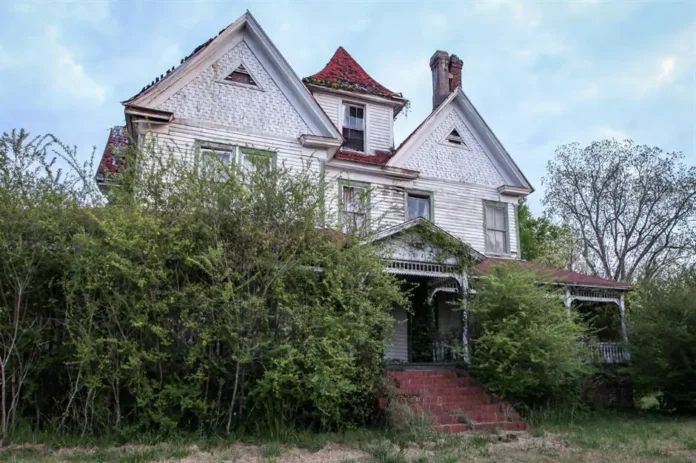Take a look at this fascinating home in Georgia, hidden away in a lush forest and filled with wildlife. It has a very interesting past. This location changed hands quite a few times in the early 1900s before Mr. Joseph McCowen bought it in 1967. He has a mixed reputation; some people find him admirable, while others don’t think much of him. However, he left a lasting impression on the region’s history and turned this house into a representation of that era. If you go inside, you’ll learn all the important information regarding its turbulent past.
This property has been neglected throughout the years, and it’s evident. The façade of the house has crumbled, the once-impressive central tower has collapsed, and some widows have even gone missing. The entire area has been overtaken by plants, with vines growing through the basement and reaching the porch roof.

Beyond the house, things aren’t all that much better. Thick black mold covers the walls, and the roof is collapsing. But in spite of everything, you could clearly see how much the orchard had grown. The facade painting on the walls is remarkably well-preserved, and the intricate courtyard ceiling showcases the location’s historical background.

Joseph McCowen, the gentleman who owed this house, was somewhat of a controversial figure. Raised in South Carolina and brought up in Harlem, he became heavily involved in the civil rights movement. He purchased this property in 1967 and set out to make some significant changes in the area. Within these walls, you will learn more about his narrative.

Upon exploring the home, you will discover some rather intriguing décor options. Bring to mind the 1970s with their bold and red paisley wallpaper—it may appear avant-garde today, but it was incredibly popular then. The mantel is polished and embellished with cool crystal chandeliers and a faux glass mirror, but the fireplace is locked shut.

The wallpaper may be coming off to reveal oak floors, but the chandelier is still holding strong. McCowen moved into this home when he was just 33 years old in order to assist Black people in Hamilton County with voter registration. Back then, the area was in terrible shape, with about half of the Black population living in poverty.

There are visible signs of wear and tear upstairs, such as moist walls and debris on the stairs. A far cry from its past splendor. However, McCow¿ founded the Eastern Committee for Opportunity (ECCO) in the early 1970s with the intention of improving Black living in Hollywood. They succeeded in garnering a great deal of support, and because of McCowen’s efforts, the country even elected its first board of commissioners with a Black majority.

With its elaborate decorations, this antique still exudes wealth and elegance. Over time, McCowen is said to have acquired more horses and livestock. Take a look at this white stairway, which is decorated with intricate carvings of blossoms and leaves, and has withstood the test of time.

Many rooms are situated off from the main lounge. A trickle of sunlight rushes through partially closed curtains, creating unsettling shadows on the dusty floorboards. A subtle floral design with a wavy-blŅ border adorns one side of the room, while a moderate wallpaper featuring pastel stripes adorns the other.

There’s hardly much left to indicate which room belongs to McCowen. A widow’s chest of drawers, a leather-upholstered metal chair, and a bouquet of red flowers are all there. Broken plates are strewn over the floor, and a large piece of wallpaper is crumpled in a corner.



